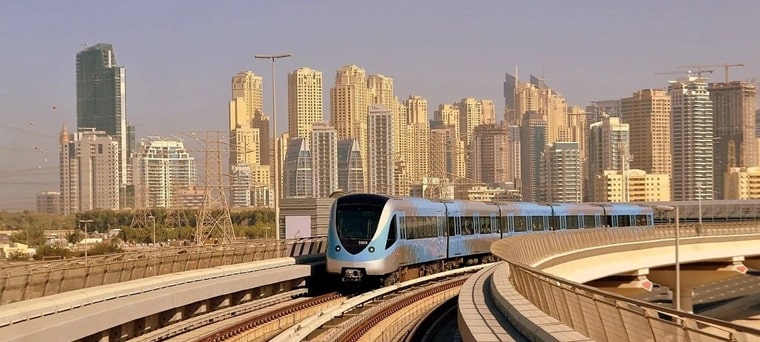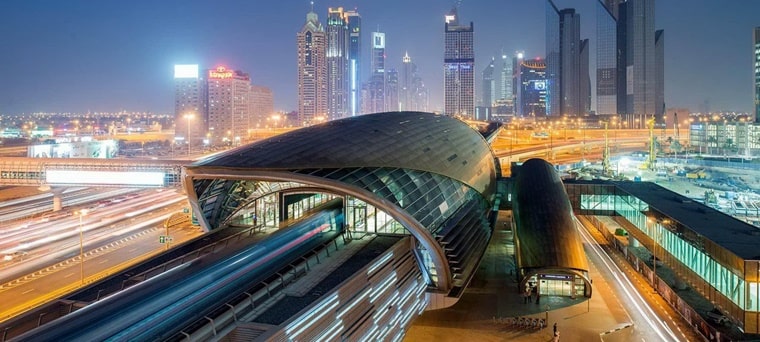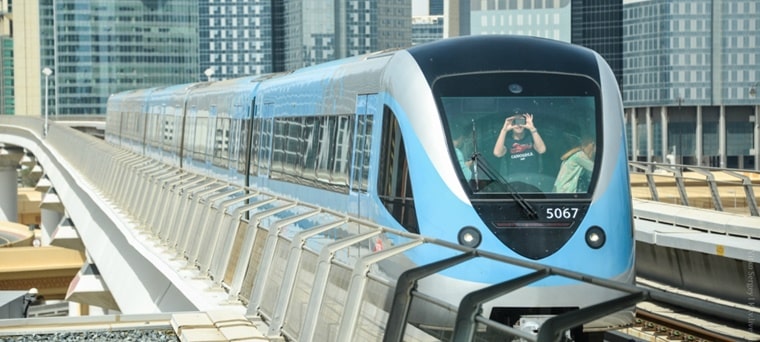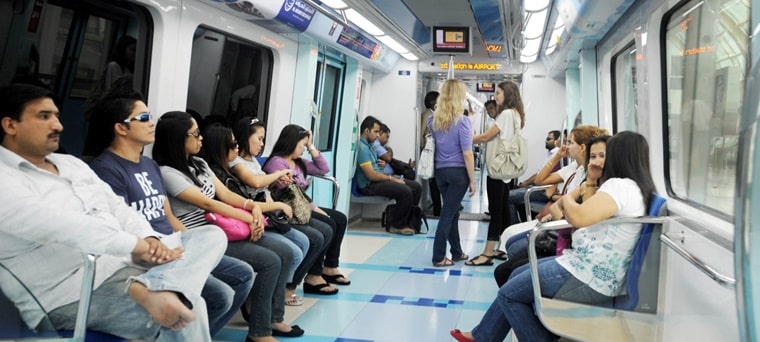

18.08.2025
885
What makes it interesting? The UAE Metro is not just a transport system, but a true work of engineering art. Opened in 2009, it became the first automated metro system in the Middle East and one of the most modern in the world.
Why is it attractive? The metro connects key areas of the city, including the tourist Burj Khalifa and Dubai Mall shopping centre. The architectural features of the stations are magnificent, each with unique design and elements of Arabic culture.
In 2006, the construction of the metro in Dubai was launched at the initiative of Sheikh Mohammed bin Rashid Al Maktoum. The main goal was to reduce traffic congestion in the city.
The construction began on March 21 of the same year. The architectural concept, including 45 stations, two depots and operational control centres, was developed by international company Aedas, known for its participation in major projects, including industrial centres, airports and multi-functional complexes located in Asia.

The Al Ghurair group, whose leader is one of the wealthiest people in the UAE, was responsible for constructing the first section of Dubai Metro’s Red Line. The company is one of the leading and oldest business groups in the city, managing vast real estate assets across the UAE.
The opening of the first section of the metro’s Red Line took place on September 9, 2009, which was a significant event for Dubai, as it was the first urban train network on the Arabian Peninsula. In the first 7 days after the metro's launch, it was used by more than 280,000 people.
Dubai Metro is a unique transport facility with a design reflecting the rich culture and history of the city. Some stations are designed in traditional Arabic style, whilst others have modern decor using glass and metal.
One of the most recognisable architectural elements of the UAE Metro is the golden handles on train carriage doors, symbolising the region's wealth. Each station features its own unique design and artistic installations, making journeys on Dubai Metro not only comfortable but also fascinating.
Dubai operates two main metro lines — Red and Green. In recent years, the number of stations has increased significantly and exceeds 50, with the majority located on the Red Line (35).
The Red Line starts from Centrepoint station, located near the airport, and stretches through the entire city along the main Sheikh Zayed Road highway. It covers many popular attractions, including the world's tallest building Burj Khalifa, Jumeirah Beach and Dubai Marina district. At Jabal Ali station, the line splits into two directions: Expo City Dubai and Ibn Battuta Mall.

The central stations of the Red Line include:
For those planning to visit Palm Jumeirah or Dubai Marina, it is recommended to use the following stations:
The UAE Metro operates automatically without drivers. To use the metro, you need to find the nearest station and pay for your journey. The direction of travel depends on the terminal station: on the Red Line it's Centrepoint (formerly Rashidiya) — UAE Exchange/EXPO 2020, and on the Green Line it's Etisalat — Creek.
Various types of tickets and cards are used to pay for travel on the UAE Metro. They can be topped up at terminals and ticket offices. Dubai's metro system requires double scanning of tickets and cards at the turnstiles upon entry and exit. There are several types of metro cards:
The Blue, Silver and Gold UAE Metro cards have a validity period of 5 years, which is convenient for regular visits to the city, as it eliminates the need for frequent card purchases. The entire metro system is divided into four zones and the fare depends on how many zones you cross. A minimum fare is charged for travel within one zone.
If you plan to spend a significant part of the day on the metro, the most cost-effective option would be purchasing a one-day ticket. Such a ticket (red colour) costs 20 dirhams. It allows unlimited journeys on the metro throughout the day, and can also be used on buses and water transport. For longer trips, you can get a monthly pass.
The UAE Metro fare depends on the distance to be covered, that is, the number of zones through which the route passes, as well as the type of card used. The entire territory of Dubai is divided into 7 transport zones, fully covered by the ground transport network, but the metro operates in only four of those zones.
To purchase and top up a Red card, you can use machines at stations or visit ticket offices, where only dirhams are accepted. Contactless payment via smartphone or bank card is also available. Silver and Gold cards can be purchased at metro stations or ground transport stops.

You must always maintain a certain amount of money on the card. Otherwise, access to the station will be restricted. For active travel around the city, a Silver card is recommended.
While you cannot withdraw money from the card, it can be used at Zoom shops located at metro stations.
The UAE Metro is known as the world's safest metro system. This has been achieved through strict rules. When travelling on Dubai Metro, you need to keep in mind the mandatory rules of conduct for passengers. Dubai Metro has numerous prohibitions, violations of which may result in various fines.
In the UAE Metro, consumption of food and drinks is prohibited (except in specially equipped cafés); same goes for smoking, sleeping and even chewing gum. It is also forbidden to carry alcoholic beverages, transport animals, and use carriage brakes or escalator stoppers unnecessarily. A violation of these rules results in fines.
The UAE Metro plays an important environmental role. It helps reduce environmental pollution and counteracts global climate change. Dubai residents who use the metro do not harm the environment as they do not contribute to increasing vehicular emissions.

It should also be noted that the UAE Metro employs advanced energy-saving technologies. For example, LED lighting and low-energy air conditioning systems. This reduces energy consumption and minimises the negative impact on the environment.
Currently, two new metro lines are being developed in the UAE: Gold and Blue, which promise to become significant catalysts for Dubai's development.
The Gold Line has been under development since 2008. Its launch is planned for 2025. This line will connect Dubai Maritime City, Nad al Sheba, Jumeirah Village Circle, Arabian Ranches, Deira and Dubai Marina.
The Blue Line, the development of which has begun recently, will connect the International Airport with key districts, including Dubai Creek Harbour, Dubai Silicon Oasis and Academic City. The construction of the Blue Line will cost $4.9 billion and add another 131 kilometres to the metro's length. Its construction is planned to be completed by 2029.
The active construction of the metro is explained by Dubai's development plans up to 2033. The city's population is expected to increase from the current 3.6 million people to 5.8 million. Thus, the growth will be more than 2 million people over 10 years, requiring the development of efficient infrastructure to ensure convenience and mobility for residents and city visitors.
Children under 5 years of age or under 90 cm in height can use travel for free. Children who do not meet these criteria require their own transport card.
During peak hours, trains arrive at 3–4 minute intervals, whilst at other times the interval is 7 minutes.
Dubai Metro is an example of high standards of engineering development. The UAE Metro abounds with modern technological innovations. There are no drivers in the trains, and the stations themselves are designed so that UAE residents can comfortably wait for trains. Thus, Dubai Metro is not just a means of transport, but an exciting experience as well.